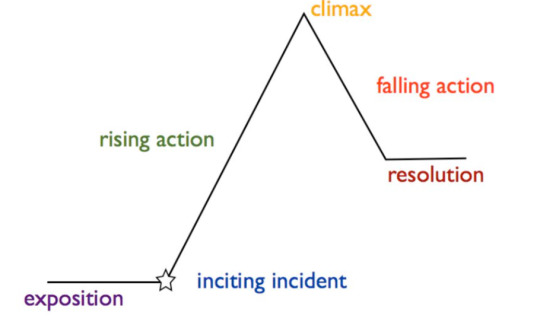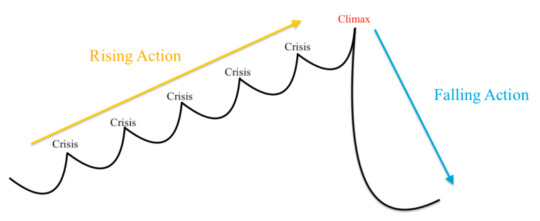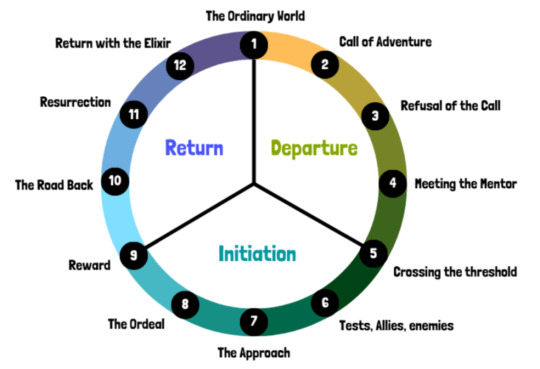#Freytag was a pre-Nazi fascist
Explore tagged Tumblr posts
Text
Not Freytag's pyramid~~.
That's stolen from a corrupted version of Antigone's diagram.

Why do I know this one to be correct and it's on Wikipedia? Because I read the whole of and tortured myself for a week reading Freytag's book Dies Tecniks Des Dramas, which for the record, is terrible, terrible on women, racism, ethnocentricism and is pretty much a mind trip into reading pre-facist propaganda as it worships Wagner's Opera.
Freytag, much like Aristotle before him is basically worshipping and justfying Wagner's Opera which was pro-German propaganda. He said EVERYONE was inferior to German drama. He went on about this at length, going so far as saying English suck ass (in a lot, lot more words whole entire diatribes of this) and the ONLY decent English ever had in his estimation was Shakespeare.
In summary, he's what you call a grade A asshole. He thought women couldn't write for shit, which is why he chose Aristotle, and he got EVERYTHING about Greek plays wrong.
And then he called Christianity the greatest religion in the world... which is how he came up with that diagram, with wrong and assumed facts about Wagner's opera, Aristotle and Shakepeare.
He also didn't promote conflict.
BTW, that's also not Hero's Journey.
You're missing the misogynistic original version of it. C'mon, put in the part where Joseph Campbell was too lazy to look up Xiqu, and thought women were either there to sleep with the hero or support him, nothing else, and then got into an argument with one of his students that the female student created her own version, even though that too, is ethnocentric media imperialism.
Don't be lazy and just take the first diagram you can find on google, because those diagrams are WRONG. Read the original work and then reel like I did at how terrible these people are, and then QUESTION the foundation of if we should be adhering to thee story structures which were extensibly invented in the 20th century (because no one follows Aristotle, the 5-act which is NOT Shakespeare in origin and is kinda lost to history, honestly, and Freytag.). Or you could just read my long, long research into the origin here: https://kimyoonmiauthor.com/post/641948278831874048/worldwide-story-structures
I've spent what? 4-5 years trying to back trace this awful thing and getting pummeled by loads of racism, sexism, while the industry worships white cis (mostly het) abled men, while ignoring the contributions of women, People of color and other minorities about story structure and I, personally, don't think that's right. We need to restore the *toehr* people and their thoughts to their rightful places and say things like, "Discovery is a valid story driver." And qichengzhuanhe is super awesome and at least 10 times older than the supposed corrupted three act story structure, which isn't really any one person these days but the worst version of telephone game ever.
Does this mean the final diagram made up of all of these different people acting like authorities without citations is "useless" no, but knowing the history of stry structure itself, I think it empowering so you know you hae a *choice* and that choice is important.
Reading the original works gives you a sense of time and plae and how things can change over time, such as where did the development part come into play into story structure, who was arguing what, and should we question it? Give yourself empowerment.
Maybe the Conflict-filled three act story structure is far better for say... horror and thrillers since it gives everyone anxiety when done right, which as I point out is great for a capitalist society. But maybe realization, discovery, self discovery, etc are better for things like romance. OMG, he actually reads Natsume Soseki, I think I'm in love.
Maybe a morality tale needs to be in Sci-fi as it looks at political issues--how do you pull that off? Silas Mariner could help. Knowing that other story drivers and story structures exist is empowering to the average writer.
Plot structure btw, I found much later is also ethnocentric and probably a after-19th century idea.
Culture need not be static. And often culture lies to you. And in this case it's a big fat lie because it's mostly holding up men who hate women and other minorities and the question for everyone is... should we stand for that when the majority of the industry are women who don't hate everyone else? Do you want to go around saying how horrible Gertrude Stein is, or rag on Black people as being "savage" or just go full on racist and religiously intolerant by saying other story structures are not valid?
There's Chaistic, for example, which is used in Jewish lore. Why not have some fun and PLAY? Isn't that what creativity is for? And if by chance people feel threatened by this and goes all Highlander on you, "There can be only one." I have to point out oppressing and saying only white men are right about everything is a terrible way to conduct business. Also, for the love of what's Holy, and for the sake of artists DO CITATIONS. I know it's tradition to not do citations on writing advice, but damn, those white men gave me a headache. And people should get credit for their ideas and work.
I bother with citations and tell when I have a new idea and where my ideas come from because I have a ense of legacy, which, BTW, doubled after I did this project and all of the white men didn't do citations and everyone else did. The more privileged you are, the less you think you have to cite say, Octavia Butler? Screw you, white uncitation men. BTW, It's a trip to read Freytag back to back with Polti. I do cite Freytag for being an asshole in full, BTW.
Let's talk about story structure.
Fabricating the narrative structure of your story can be difficult, and it can be helpful to use already known and well-established story structures as a sort of blueprint to guide you along the way. Before we delve into a few of the more popular ones, however, what exactly does this term entail?
Story structure refers to the framework or organization of a narrative. It is typically divided into key elements such as exposition, rising action, climax, falling action, and resolution, and serves as the skeleton upon which the plot, characters, and themes are built. It provides a roadmap of sorts for the progression of events and emotional arcs within a story.
Freytag's Pyramid:
Also known as a five-act structure, this is pretty much your standard story structure that you likely learned in English class at some point. It looks something like this:

Exposition: Introduces the characters, setting, and basic situation of the story.
Inciting Incident: The event that sets the main conflict of the story in motion, often disrupting the status quo for the protagonist.
Rising Action: Series of events that build tension and escalate the conflict, leading toward the story's climax.
Climax: The highest point of tension or the turning point in the story, where the conflict reaches its peak and the outcome is decided.
Falling Action: Events that occur as a result of the climax, leading towards the resolution and tying up loose ends.
Resolution (or Denouement): The final outcome of the story, where the conflict is resolved, and any remaining questions or conflicts are addressed, providing closure for the audience.
Though the overuse of this story structure may be seen as a downside, it's used so much for a reason. Its intuitive structure provides a reliable framework for writers to build upon, ensuring clear progression and emotional resonance in their stories and drawing everything to a resolution that is satisfactory for the readers.
The Fichtean Curve:
The Fichtean Curve is characterised by a gradual rise in tension and conflict, leading to a climactic peak, followed by a swift resolution. It emphasises the building of suspense and intensity throughout the narrative, following a pattern of escalating crises leading to a climax representing the peak of the protagonist's struggle, then a swift resolution.

Initial Crisis: The story begins with a significant event or problem that immediately grabs the audience's attention, setting the plot in motion.
Escalating Crises: Additional challenges or complications arise, intensifying the protagonist's struggles and increasing the stakes.
Climax: The tension reaches its peak as the protagonist confronts the central obstacle or makes a crucial decision.
Swift Resolution: Following the climax, conflicts are rapidly resolved, often with a sudden shift or revelation, bringing closure to the narrative. Note that all loose ends may not be tied by the end, and that's completely fine as long as it works in your story—leaving some room for speculation or suspense can be intriguing.
The Hero’s Journey:
The Hero's Journey follows a protagonist through a transformative adventure. It outlines their journey from ordinary life into the unknown, encountering challenges, allies, and adversaries along the way, ultimately leading to personal growth and a return to the familiar world with newfound wisdom or treasures.

Call to Adventure: The hero receives a summons or challenge that disrupts their ordinary life.
Refusal of the Call: Initially, the hero may resist or hesitate in accepting the adventure.
Meeting the Mentor: The hero encounters a wise mentor who provides guidance and assistance.
Crossing the Threshold: The hero leaves their familiar world and enters the unknown, facing the challenges of the journey.
Trials and Tests: Along the journey, the hero faces various obstacles and adversaries that test their skills and resolve.
Approach to the Inmost Cave: The hero approaches the central conflict or their deepest fears.
The Ordeal: The hero faces their greatest challenge, often confronting the main antagonist or undergoing a significant transformation.
Reward: After overcoming the ordeal, the hero receives a reward, such as treasure, knowledge, or inner growth.
The Road Back: The hero begins the journey back to their ordinary world, encountering final obstacles or confrontations.
Resurrection: The hero faces one final test or ordeal that solidifies their transformation.
Return with the Elixir: The hero returns to the ordinary world, bringing back the lessons learned or treasures gained to benefit themselves or others.
Exploring these different story structures reveals the intricate paths characters traverse in their journeys. Each framework provides a blueprint for crafting engaging narratives that captivate audiences. Understanding these underlying structures can help gain an array of tools to create unforgettable tales that resonate with audiences of all kind.
Happy writing! Hope this was helpful ❤
#story structure#Freytag was an asshole#Freytag was a pre-Nazi fascist#Don't forget Fretyag was super racist#Campbell was racist and sexist. c'mon#Do citations
396 notes
·
View notes